Learning the sport of candlepin bowling from scratch is like learning a new language, so I’ve put together this glossary of candlepin bowling terms so you can keep it all straight. (I left out all the 4-letter words you’ll use while playing this game—those you know already, I’m sure.) Let’s roll…
Glossary of candlepin bowling terms
Here are all the candlepin bowling terms you need to know, listed in alphabetical order. Scroll through the whole list or click on a letter to skip to that section.
# A B C D E F G H I J K L M N O P Q R S T U V W X Y Z

Numbered candlepin bowling terms
9-Drop – When 9 pins are knocked down with the first ball; you can use any number in this case (a 6-drop, an 8-drop, etc.)
10-Box – When all 10 pins are knocked down with three balls; scored as a 10
Candlepin bowling terms: A
Approach – This can refer to either:
- The area of the bowling lane where the bowler begins his/her movement (ending at the foul line); or
- The movements a bowler takes before and during delivery; can involve a 3-step ‘approach,’ a 5-step ‘approach,’ etc.; each bowler has his/her own unique ‘approach.’
Arrows – The (usually) triangular marks on each bowling lane used for aiming the ball. They’re positioned about a quarter of the way down the lane from the foul line.
Average – This refers to the average score of a string for a league bowler. It typically takes a minimum of 30 strings to establish one’s ‘average.’
Candlepin bowling terms: B
Back Door Strike – A strike in which the head pin is the last one to fall down
Box – There are 10 boxes in a string (game). A ‘box’ typically consists of 3 balls; the pins are reset either after all the pins have been knocked down or after the 3rd ball has been rolled, whichever comes first. ‘Box’ is used interchangeably with ‘frame.’
Candlepin bowling terms: C
Cap – Each pin has a cap on the top and bottom. If the ball strikes wood on the ‘cap,’ it will shoot the pin in the direction the pin is pointed.
Cross Over – When a right-handed bowler hits the left pocket (the space between the #1 and #2 pin); or when a left-handed bowler hits the right pocket (the space between the #1 and #3 pins)
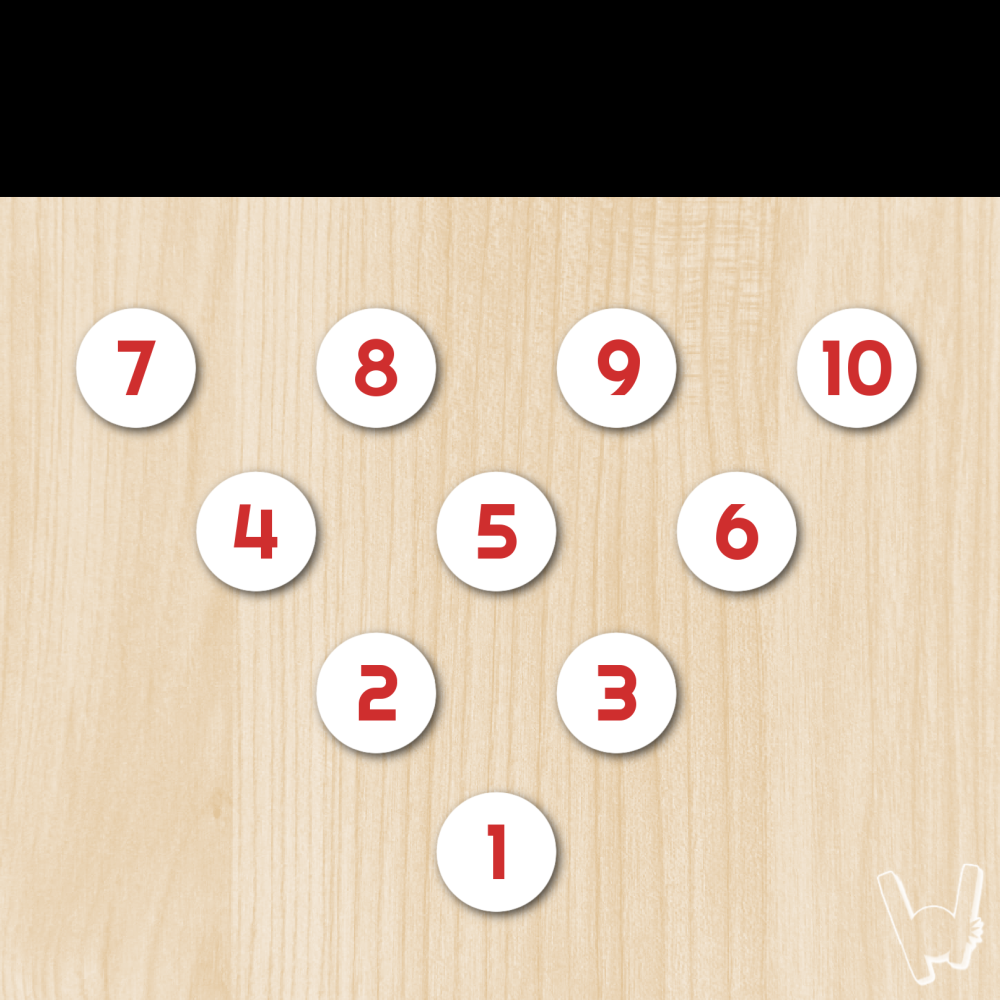
Candlepin bowling terms: D
Dead Wood – Refers to fallen pins that are lying in the gutter or on the lane either in front of or touching the ‘deadwood’ line. Dead wood on the lane must be removed before the bowler can roll his next ball, but dead wood in the gutter is left alone. If the ball hits any dead wood before it hits any standing or fallen pins on the lane, that ball is considered ‘dead’ and any pins knocked down by it don’t count towards the bowler’s score.
Deadwood Line – Horizontal line across the lane 24 inches in front of the head pin. Any pin touching or lying on the bowler’s side of the ‘deadwood line’ is considered dead wood. (see above) When you see a bowler or alley employee running down the lane all the way to the pins, it’s usually to check if a pin is ‘dead wood.’ If the pin is deemed as such, it’s removed.
Deck – The area where the pins stand
Diamond – When four pins form a diamond-shaped configuration; examples:
- “Left-side diamond” = the 2-4-5-8 pins
- “Right-side diamond” = the 3-5-6-9 pins
- “Center diamond” = the 1-2-3-5 pins
- In standard ten-pin bowling this is referred to as a “bucket.”
Double – Two consecutive strikes
Candlepin bowling terms: F
Farqy – A split with only the 5-7-10 pins left standing; also known as a ‘lily’ or ‘sour apple’ in ten-pin, and ‘hope, faith, and charity’ in duckpin bowling.
Fill – The next ball after a spare or the next two balls after a strike. The number of pins knocked down with the ‘fill’ adds to the score which allows a score greater than 10 in a single box. The max score of one box is 30—when a strike is filled by two more strikes.
Foul Line – The horizontal line at the start of the lane where the bowler typically releases the ball. If a bowler’s foot, body, or clothing touches or crosses the foul line during or after delivery of the ball, the shot is considered a foul and any pins knocked down won’t count toward the score.
Four Bagger – Four consecutive strikes
Four Horsemen – Four pins that form a diagonal line from the head pin outward. Examples:
- “Four horsemen, left side” = the 1-2-4-7 pins
- “Four horsemen, right side” = the 1-3-6-10 pins
- In tenpin this is known as a “picket fence” or a “clothesline.”
Frame – There are 10 frames in a string (game). A ‘frame’ typically consists of 3 balls; the pins are reset either after all the pins have been knocked down or after the 3rd ball has been rolled, whichever comes first. ‘Frame’ is used interchangeably with ‘box.’
Full Worcester – When you knock down the 2-3-8-9 pins with the first 2 balls thrown (i.e., two Half Worcesters) Both the Full Worcester and the Half Worcester are demonstrated in this video.

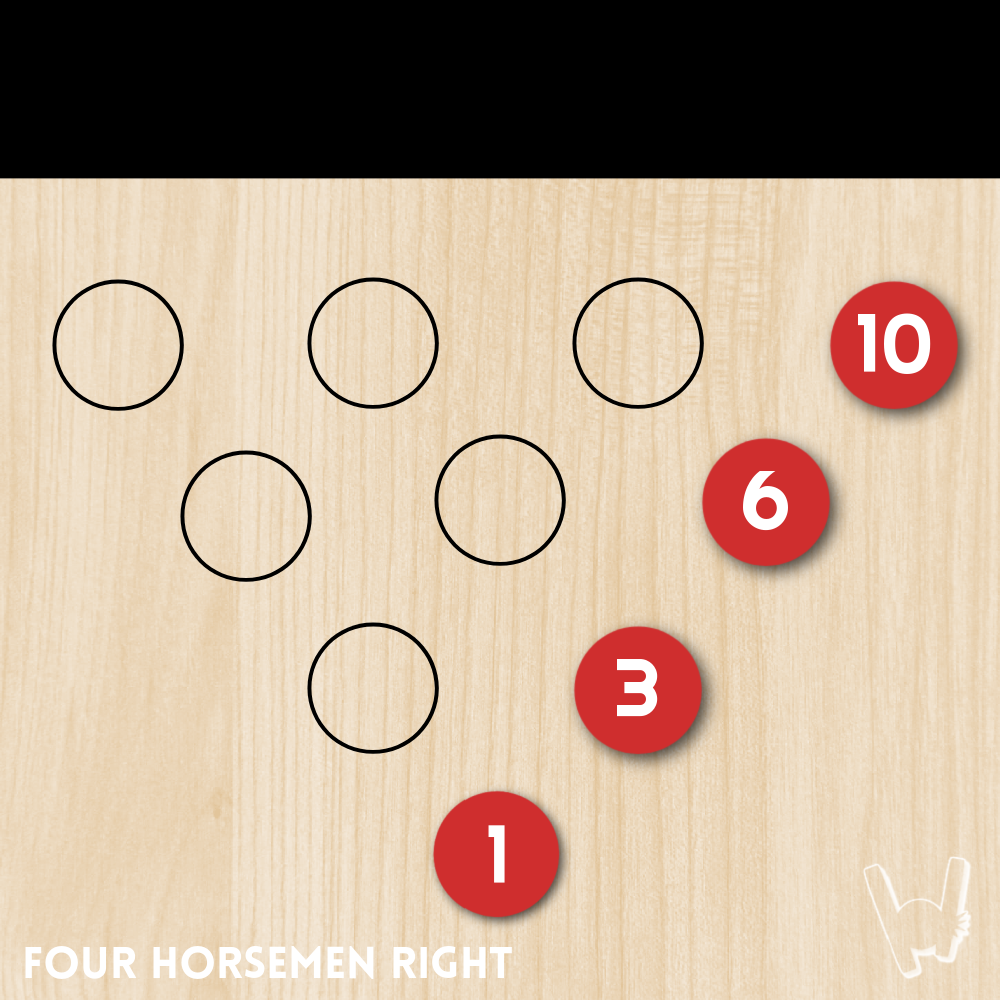
Candlepin bowling terms: H
Half Worcester – When you knock down only the 2-8 pins or the 3-9 pins. This happens when the first shot strikes either the 2-pin or 3-pin too directly and “punches out” only that pin and the one immediately behind it.
- Half Worcester left = when only the 2- and 8-pins fall
- Half Worcester right = when only the 3- and 9-pins fall
- See what a Half Worcester looks like in this video.
(According to legend) the term comes from when a team from Worcester was competing against a team from Boston in the semifinal round of a statewide tournament sometime in the 1940s. Late in the last match of the round, one of the bowlers needed a mark but instead “punched out” only two such pins with his first ball. This prompted a member of the Boston team to taunt him by saying, “You’re halfway back to Worcester!”
Hammer – A strike where all 10 pins are knocked down in an almost simultaneous fashion
Head Pin – The 1-pin; the pin in front of all the other pins
Hi-Lo-Jack – When only the 1, 7, and 10 pins are left. The term originated when this shot was set up for both competitors to attempt at the end of the WCVB/WHDH “Candlepin Bowling” program each week. For each week the shot wasn’t made, the “Hi-Lo-Jackpot” increased by $25. (The “Candlepin Bowling” program on WCVB/WHDH ran from 1958-1996 and was hosted by Don Gillis and Jim Britt.)
Candlepin bowling terms: K
King Pin – The 5-pin; the one in the center surrounded by all the other pins and directly behind the head pin

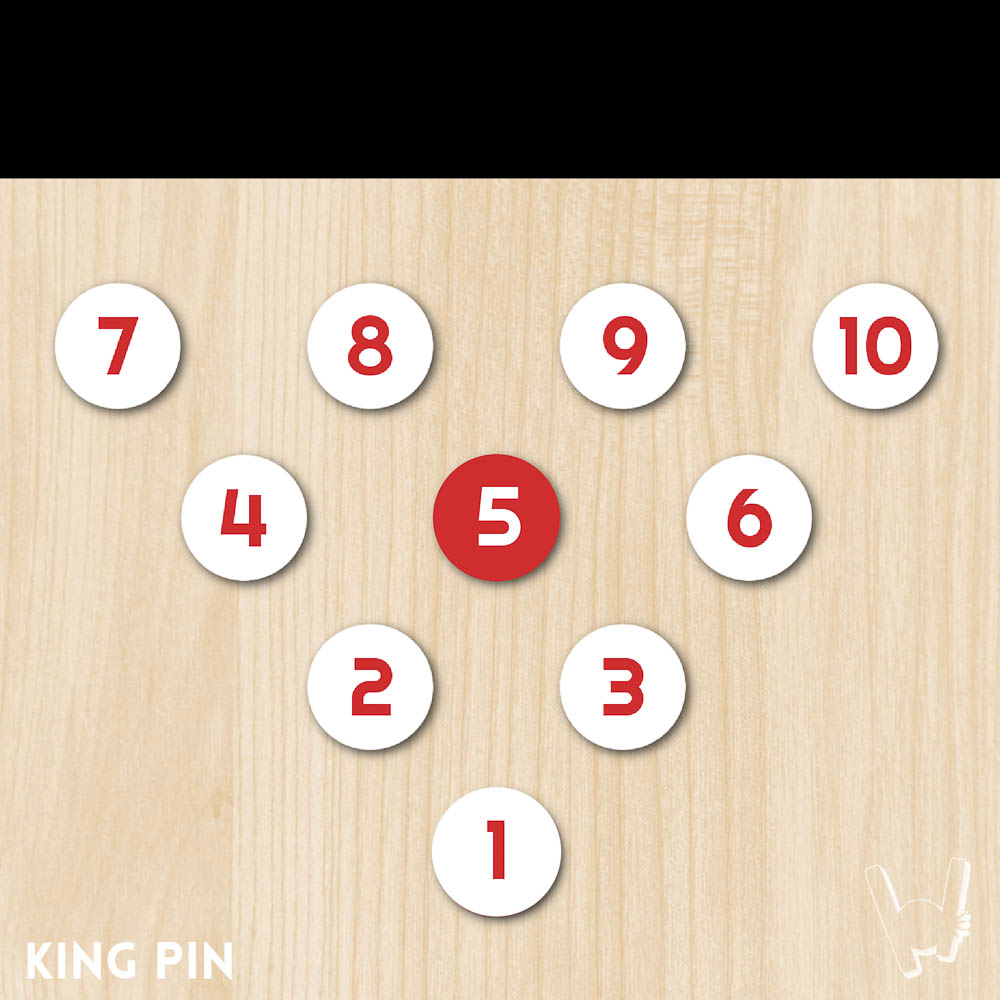
Candlepin bowling terms: L
League Bowler – A bowler that bowls as part of a candlepin bowling league
Leave – The configuration of pins remaining after the 1st and 2nd balls have been rolled
Lob Line – A horizontal line across the lane 10 feet past the foul line. A fair throw must first make contact with the lane ahead of the lob line.
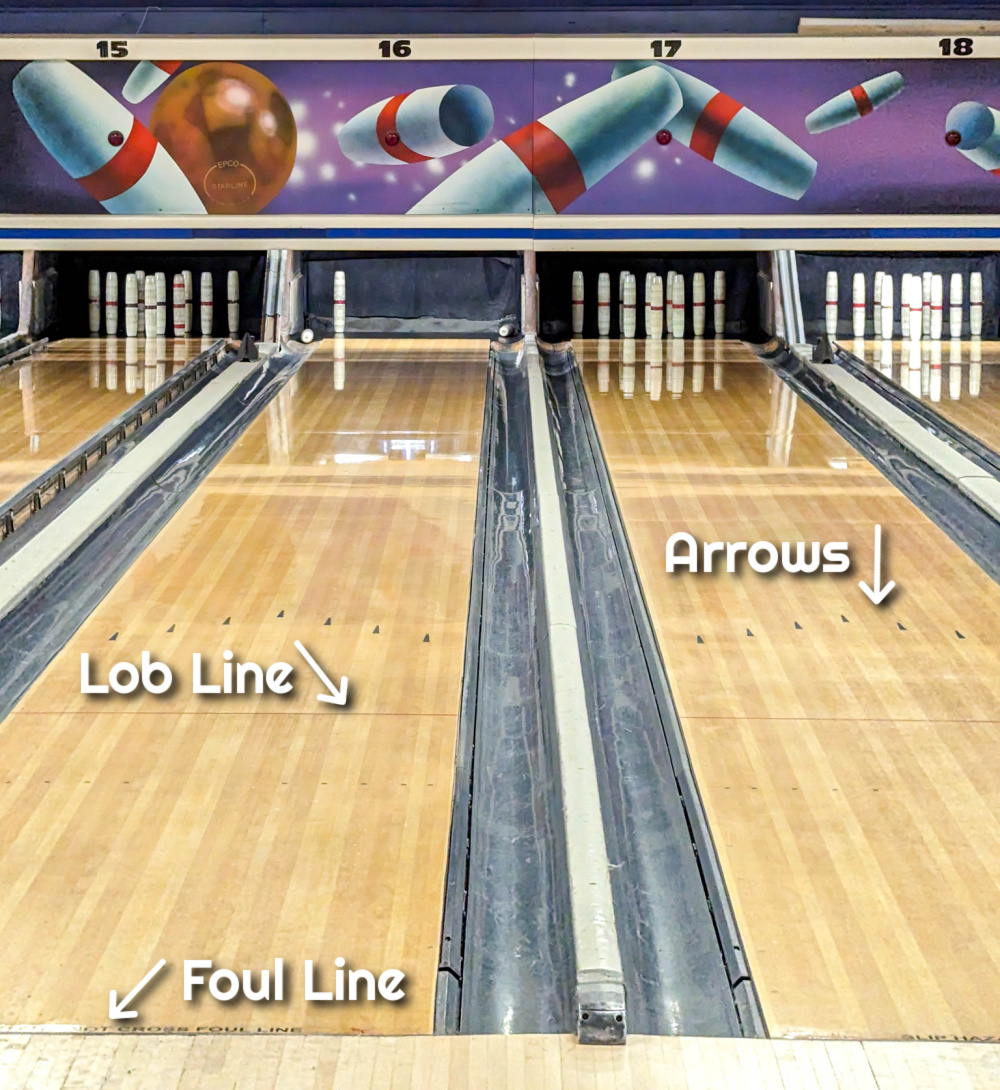
Candlepin bowling terms: M
Mark – A scoring term denoting either a spare or a strike has been thrown
Candlepin bowling terms: O
Object Pin – Whichever pin the bowler was aiming for
Candlepin bowling terms: P
Perfect Game – When there are no pins left standing at the end of each box, meaning the bowler scored either a 10, a spare, or a strike in each frame. The lowest possible score of a ‘perfect game’ is 100.
Pinning – This refers to hitting the object pin with the 3rd ball (i.e., not leaving many pins on the deck). Good ‘pinning’ equals higher scores.
Plank – When wood (fallen pins) is lying down horizontally in front of a pin or pins (which gives a larger target to aim at to knock down the rest of the standing pins)
Pocket – The space between the 1-2 and 1-3 pins. For the best pin action, the general goal is to aim so that your first ball strikes the pocket.

Candlepin bowling terms: Q
Quarter Worcester – Another term derived from the Half Worcester but which means to knock down half as many pins—either just the 2-pin or just the 3-pin
Candlepin bowling terms: R
Rack – A full set of 10 pins on the deck
Red Line – The middle of the pin that’s marked with red tape; this is used for aiming.
Candlepin bowling terms: S
Spare – When all 10 pins are knocked down with the 1st and 2nd balls. The number of pins knocked down on the next ball of the following frame counts in the scoring of that frame. (This is also called the ‘fill.’)
Spread Eagle – A split configuration that leaves the 2-3-4-6-7-10 pins; this is caused by the first shot striking the head pin too directly which thus fails to scatter the rest of the pins.
Strike – When all 10 pins are knocked down with the 1st ball of the frame. The number of pins knocked down on the next two balls of the following frames counts in the scoring of that frame. (This is also called the ‘fill.’)
String – One game of bowling; a string consists of 10 frames/boxes.
Candlepin bowling terms: T
Triangle – When either the 1-2-3 pins, the 2-4-5 pins, the 3-5-6 pins, the 4-7-8 pins, the 5-8-9 pins, or the 6-9-10 pins are left standing
Triple – This can refer to either:
- A three-game series – As in, “He bowled a 500-triple.” This means the bowler scored 500 points across three games; or
- Three consecutive strikes (In ten-pin this is referred to as a ‘turkey.’)
Two-Three Split – A split that leaves a grouping of 2 pins on one side and another grouping of 3 pins on the other side (There can be other variations as well, i.e., one-two split, two-two split, one-four split, etc.)
Candlepin bowling terms: W
Where to go candlepin bowling – For the full list of every active candlepin bowling in the U.S. and Canada, check out my full guide to Where to Go Candlepin Bowling.
Wood – The fallen pins lying between the standing pins; these are often strategically used to knock down additional standing pins. (Wood that has fallen in the gutter or too far up on the lane is known as ‘dead wood.’)
Woolworth Split – A split where only the #5 and 10 pins remain standing. This term refers to the once-ubiquitous “five and dime” stores commonly found throughout the United States.
Like this post? Have questions about candlepin bowling terms? Let me know in the comments below!
Save this info, pin this image:


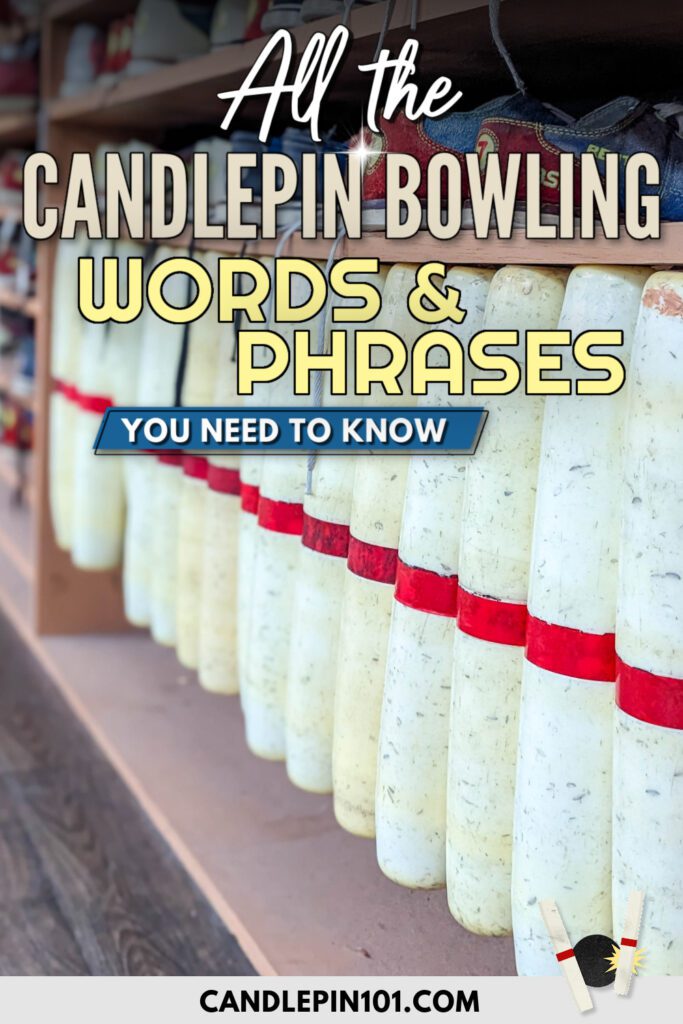
 Candlepin Bowling Near Me (2025): How to Find Your Best Local Alley
Candlepin Bowling Near Me (2025): How to Find Your Best Local Alley
Nicely Done
I am Ralph Semb, President ICBA Owner French King Bowling Center Erving, MA 01344
Treasurer and Past President WNECA
Thanks, Ralph! I appreciate that.